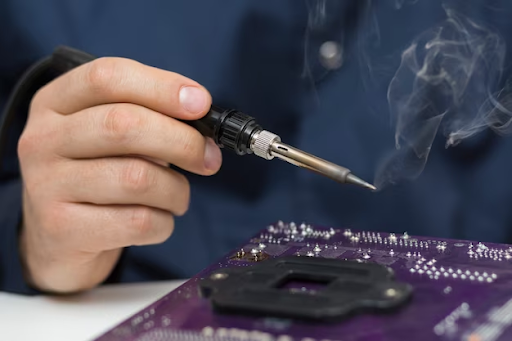Even carefully made objects have a limited lifespan. Over time, electronic components like PCBs experience wear and tear and eventually must be replaced or repaired for the device’s general health.
Printed circuit boards, sometimes known as PCBs, have been used for many years. They support a range of electronic components thanks to their pads and conductive tracks. They are now a common option for practically all manufacturers of electrical devices. If your PCB board is broken, you can contact a reputable PCB board repair service in your neighborhood for assistance.
Importance of Maintaining Proper Functioning PCBs.
Your PCB may have flaws or damage that causes unpredictable behavior, periodic failures, or total device breakdowns.
A defective PCB can be a safety risk due to overheating or electrical dangers.
It can be difficult to learn how to replace or repair PCBs on your own, but resolving minor faults before they become big ones can reduce downtime, avoid damage to other components, and increase the lifespan of your devices.
Five Signs That Your PCB May Need Fixing Or Replacing
Here are five warning indicators that your PCBs may malfunction due to damage or errors, along with some advice on fixing the PCB.
Power Loss That Is Intermittent Or Complete
Determine the source of the power loss first, which may or may not be related to the PCB.
How to Fix Power Problems
- Check that the cable and connections are intact and the power source is operating properly.
- In particular, look for loose or damaged connections between the solder joints’ power input and output portions. Pay special attention to electrical parts such as fuses, diodes, and voltage regulators.
- Inspect the continuity of the traces connecting the components using a multimeter; if necessary, a PCB trace repair may be required to reopen a broken circuit.
Replacement or Repair for Power Issues
- Resoldering the junction or fixing the trace carefully can solve the problem of loose connections.
- Consider replacing the PCB if numerous components are harmed, or the problem is too challenging to pinpoint.
Burn Marks Or Overheating On The PCB
Overheating can be brought on by inadequate ventilation or exposure to high temperatures through other device components. In particular, heat-sensitive components like diodes, capacitors, and resistors might experience overheating and increased current flow due to short circuits.
Prevention and Cooling Techniques
To avoid overheating, make sure your PCB has access to adequate ventilation and airflow. Consider the device’s overall architecture to enable the passage of cold air over the PCB.
To be sure there are no unintentional connections amongst traces or components that could result in short circuits, visually inspect the area or use a multimeter.
It could be best to replace the PCB if you see significant burn damage, damage to many parts, or if you can’t identify the source of the overheating.
Defective or Inattentive Components
Your device’s functionality may not be as intended in some areas, which could result from faulty or unresponsive PCB components.
- Identifying Faulty Components
- Test each component’s operation with a multimeter.
- Check connections to make sure all parts are firmly soldered and secure.
- On the PCB, look for broken or damaged traces.
- The significance of correctly soldering and installing components
Your PCB may have several issues as a result of improperly soldered parts, including:
- Difficulties with electrical connectivity, such as open and short circuits.
- Cold joints cause weak bonding and sporadic connections.
- Flux remnants and solder splatter.
- Surface-mount technology (SMT) reflow soldering errors might result in reflow problems. Due to uneven heating, some components may lift off the PCB.
Physical Damage or Corrosion That Can Be Seen
Components with chips, cracks, or bends may indicate that your PCB has sustained long-term harm.
- Look for less visible indications of corrosion, color change, moisture damage, and obvious physical flaws like cracks or chips. Look for deposits that are white or greenish surrounding parts or traces.
- Visual examinations should concentrate on various board components and be repeated several times. Components should come first, followed by solder joints, traces, and circuits. The inspection procedure can be broken down to make finding and recording each concern simpler.
- Whether necessary, you can gently bend or apply light pressure to your PCB to examine whether any components are shifting or breaking as a result of weak connections.
Corrosion And Environmental Damage Management
Components physically harmed can be desoldered and changed for new ones.
- Isopropyl alcohol or a specific cleaning solution can remove some corrosion. However, you should consider replacing the complete PCB if the corrosion is severe or pervasive.
- Open circuits or frequent circuit shortages
- You can realize your device is unreliable, unexpected, or broken during routine use. On the PCB, there may be a lack of circuits to account for this.
Short-Circuit And Open-Circuit Diagnosis
- Using a multimeter is the simplest technique to check for shorted or open circuits; a closed circuit will show minimal resistance, while an open circuit will show infinite resistance.
- Keep an eye out for accidental connections between nearby traces or parts.
- Look for any trace discontinuities on the PCB.
There are various elements to consider while looking for a reputable PCB repair service provider nearby, such as certifications and standards, since these assure that the selected repair service provider has the knowledge required to do these services. It’s crucial to confirm whether the service provider sources their components from trustworthy sources or relies on dependable suppliers. Avoid repair services that cannot ensure high-quality replacements.
You may quickly get a PCB fixed if it isn’t functioning properly by locating a reputable PCB repair service provider.
